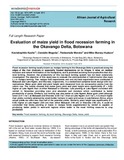Please use this identifier to cite or link to this item:
http://hdl.handle.net/10311/1392Full metadata record
| DC Field | Value | Language |
|---|---|---|
| dc.contributor.author | Kashe, Keotshephile | - |
| dc.contributor.author | Mogobe, Oarabile | - |
| dc.contributor.author | Morake, Thebeetsile | - |
| dc.contributor.author | Murray-Hudson, Mike | - |
| dc.date.accessioned | 2015-07-07T04:38:01Z | - |
| dc.date.available | 2015-07-07T04:38:01Z | - |
| dc.date.issued | 2015-04-09 | - |
| dc.identifier.citation | Kashe, K. et.al (2015) Evaluation of maize yield in flood recession farming in the Okavango Delta, Botswana, African Journal of Agricultural Research,Vol. 10, No. 16, pp. 1874-1879 | en_US |
| dc.identifier.issn | 1991-637X (print) | - |
| dc.identifier.uri | http://hdl.handle.net/10311/1392 | - |
| dc.description | First published by Academic Journals, April 2015 | en_US |
| dc.description.abstract | Flood recession farming locally known as molapo farming in the Okavango Delta is practiced along the edges of the river channels or seasonally flooded depressions on its fringes. It relies on residual moisture and natural fertilization of the floodplains, and is promoted as being more productive than dry-land farming. However, the productivity of this low-input farming system has not been extensively investigated. The objective of this study was to evaluate the yield potential of hybrid maize (Zea mays L.) in molapo farming. Two molapo field experiments and one dry-land experiment were conducted at Matsaudi and Lake Ngami, and Shorobe, respectively, in a randomized complete block design with four replications. Maize grain yield and plant height were measured from six consecutive plants from the centre row. The results showed that maize grain yield and plant height were significantly (P < 0.05) higher at Lake Ngami than at either Matsaudi or Shorobe. Late planting at Lake Ngami coincided with rainfall in November providing even and abundant soil moisture which contributed to better productivity of maize. Similarly, soil fertility was also better at Lake Ngami. Maize grain yield although lower (2.41 t ha-1) at Matsaudi and Shorobe (2.58 t ha-1) than at Lake Ngami (3.4 t ha-1), it is much higher than yields normally obtained by small-holder farmers in semi-arid zones in sub-Saharan Africa, where actual yields are often less than half of the potential yields. Similarly, plant height was significantly (P < 0.05) higher at Lake Ngami (235 cm) than either Matsaudi (194 cm) or Shorobe (192 cm). It could be concluded that timely planting of maize in molapo fields supplemented by rainfall is capable of producing better yields in semi-arid regions where water is the most limiting resource to crop production. | en_US |
| dc.description.sponsorship | This study was funded by the Okavango Research Institute, University of Botswana | en_US |
| dc.language.iso | en | en_US |
| dc.publisher | Academic Jornals, http://www.academicjournals.org | en_US |
| dc.rights | This article is published under the terms of the Creative Commons Attribution License 4.0 | en_US |
| dc.subject | Flood recession farming | en_US |
| dc.subject | Dry-land farming | en_US |
| dc.subject | Okavango delta | en_US |
| dc.subject | Maize | en_US |
| dc.subject | Yield | en_US |
| dc.title | Evaluation of maize yield in flood recession farming in the Okavango Delta, Botswana | en_US |
| dc.type | Published Article | en_US |
| dc.rights.holder | The authors retain the copyright of this article. | en_US |
| dc.link | http://www.academicjournals.org/journal/AJAR/article-full-text/7629CAB52490 | en_US |
| Appears in Collections: | Research articles (ORI) | |
Files in This Item:
| File | Description | Size | Format | |
|---|---|---|---|---|
| Kashe et al_AJA_2015.pdf | Main Article | 520.01 kB | Adobe PDF |  View/Open |
Items in DSpace are protected by copyright, with all rights reserved, unless otherwise indicated.
